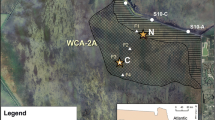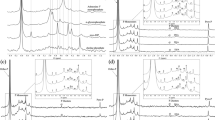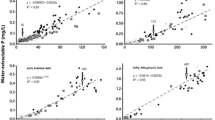Abstract
Incidental losses of dissolved reactive phosphorus (DRP) to a surface waterbody originate from direct losses during land application of fertilizer, or where a rainfall event occurs immediately thereafter. Another source is the soil. One way of immobilising DRP in runoff before discharge to a surface waterbody, is to amend soil within the edge of field area with a high phosphorus (P) sequestration material. One such amendment is iron ochre, a by-product of acid mine drainage. Batch experiments utilising two grassland soils at two depths (topsoil and sub-soil), six ochre amendment rates (0, 0.15, 1.5, 7.5, 15 and 30 g kg−1 mass per dry weight of soil) and five P concentrations (0, 5, 10, 20 and 40 mg L−1) were carried out. A proportional equation, which incorporated P sources and losses, was developed and used to form a statistical model. Back calculation identified optimal rates of ochre amendment to soil to ameliorate a specific DRP concentration in runoff. Ochre amendment of soils (with no further P inputs) was effective at decreasing DRP concentrations to acceptable levels. A rate of 30 g ochre kg−1 soil was needed to decrease DRP concentrations to acceptable levels for P inputs of ≤10 mg L−1, which represents the vast majority of cases in grassland runoff experiments. However, although very quick and sustained metal release above environmental limits occurred, which makes it unfeasible for use as a soil amendment to control P release to a waterbody, the methodology developed within this paper may be used to test the effectiveness and feasibility of other amendments.



Similar content being viewed by others
References
Abu-Zreig, M., Rudra, R. P., Whiteley, H. R., Lalonde, M. N., & Kaushik, N. K. (2003). Phosphorus removal in vegetated filter strips. Journal of Environmental Quality, 32, 613–619.
Beltman, D. J., Clements, W. H., Lipton, J., & Cacela, D. (1999). Benthic invertebrate metals exposure, accumulation, and community-level effects downstream from a hard-rock mine site. Environmental Toxicology and Chemistry, 18, 2999–307.
Bozika, E. (2001). Phosphorus removal from wastewater using sludge from mine drainage treatment settling ponds. University of Edinburgh. Unpublished MSc thesis.
Brennan, R. B., Fenton, O., Rodgers, M., & Healy, M. (2011). Evaluation of chemical amendments to control phosphorus losses from dairy slurry. Soil Use and Management, 27(2), 238–246.
BSI. (1989). BS 1796: Method of test for soils for civil engineering purposes. BS 1796. London: British Standards Institution.
Clements, W. H., Cherry, D. S., & Van Hassel, J. H. (1992). Assessment of the impact of heavy metals on benthic communities at the Clinch River (Virginia): Evaluation of an index of community sensitivity. Canadian Journal of Fisheries and Aquatic Science, 49, 1686–1694.
Council of the European Union. (2009). European Communities environmental objective (surface waters) regulations. S.I. No. 272 of 2009.
Cucarella, V., & Renman, G. (2009). Phosphorus sorption capacity of filter materials used for on-site wastewater treatment determined in batch experiments—A comparative study. Journal of Environmental Quality, 38, 381–392.
Curran, F. (2001). Ecological and ecotoxicological investigation of ongoing discharge of acid mine drainage (AMD) from the abandoned Avoca copper mines, Co. Wicklow. PhD Thesis, University College Dublin.
Dobbie, K. E., Heal, K. V., Aumonier, J., Smith, K. A., Johnston, A., & Younger, P. L. (2009). Evaluation of iron ochre from mine drainage treatment for removal of phosphorus from wastewater. Chemosphere, 75, 795–800.
Dorioz, J. M., Wang, D., Poulenard, J., & Trévisan, D. (2006). The effect of grass buffer strips on phosphorus dynamics—A critical review and synthesis as a basis for application in agricultural landscapes in France. Agriculture, Ecosystems and Environment, 117, 4–21.
Elliott, H. A., O’Connor, G. A., Lu, P., & Brinton, S. (2002). Influence of water treatment residuals on phosphorus solubility and leaching. Journal of Environmental Quality, 31, 1362–1369.
European Community (2005). Agri-environment Measures. European Commission/Directorate General for Agriculture and Rural Development.
Fenton, O., Healy, M. G., & Rodgers, M. (2007). Assessing the performance of phosphorus retention using an Avoca–Avonmore catchment, ochre, Ireland. In IAH (Ed.), Securing Groundwater Quality in Urban and Industrial Environments (Proc. 6th International Groundwater Quality Conference). Fremantle: IAH.
Fenton, O., Healy, M. G., & Rodgers, M. (2009a). Use of ochre from an abandoned metal mine in the South East of Ireland for phosphorus sequestration from dairy dirty water. Journal of Environmental Quality, 38, 1120–1125.
Fenton, O., Healy, M. G., Rodgers, M., & ÓhUallacháin, D. (2009b). Site-specific P absorbency of ochre from acid mine drainage near an abandoned Cu-S mine in the Avoca–Avonmore catchment, Ireland. Clay Minerals, 44, 113–123.
Fenton, O., Serrenho, A., & Healy, M. G. (2011). Evaluation of amendments to control phosphorus losses in runoff from dairy-soiled water. Water, Air, and Soil Pollution, 1–10. doi:10.1007/s11270-011-0815-8.
Gallimore, L. E., Basta, N. T., Storm, D. E., Payton, M. E., Huhnke, R. H., & Smolen, M. D. (1999). Water treatment residual to reduce nutrients in surface runoff from agricultural land. Journal of Environmental Quality, 28, 1474–1478.
Hancock, S. (2005). Quantifying ochre arisings: Output from the U.K. Coal Authority’s Mine Water Treatment sites. 9th International Mine Water Conference.
Heal, K. V., Younger, P. L., Smith, K. A., McHaffie, H., & Batty, L. C. (2004). Removing P from sewage effluent and agricultural runoff using ochre recovered from mine water treatment. In E. Valsami-Jones (Ed.), Phosphorus in environmental technology: Removal, recovery and applications (pp. 320–334). London: IWA Publishing.
Heal, K. V., Dobbie, K. E., Bozika, E., McHaffie, H., Simpson, A. E., & Smith, K. A. (2005). Enhancing phosphorus removal in constructed wetlands with ochre from mine drainage treatment. Water Science and Technology, 51, 275–282.
Johansson-Westholm, L. (2006). Substrates for phosphorus removal—Potential benefits for on-site wastewater treatment? Water Resources, 40, 23–36.
Kurz, I., Tunney, H., & Coxon, C. E. (2005). The impact of agricultural management practices on nutrient losses to water: Data on the effects of soil drainage characteristics. Water Science and Technology, 51, 73–81.
Leonard, C., Mullen, G. J., Culleton, N., & Breen, J. (2006). Soil properties and their influence on grassland production under low input and organic farming conditions. End of Project Report 4478, www.teagasc.ie
O’ Flynn, C., Fenton, O., & Healy, M. G. (2011). Evaluation of amendments to control phosphorus losses in runoff from pig slurry applications to land. Clean –Air, Soil, Water (in press).
Penn, C., Bryant, R. B., Kleinman, P. J. A., & Allen, A. L. (2007). Removing dissolved phosphorus from drainage ditch water with oxyhydroxides. 17th National Meeting of the American Society for Surface Mining and Reclamation, Tampa, Florida.
Pratt, P. F., & Blair, F. L. (1963). Buffer method for estimating lime and sulphur applications for pH control of soils. Soil Science, 93, 329–331.
Preedy, N., McTiernan, K., Matthews, R., Heathwaite, L., & Haygarth, P. (2001). Rapid incidental phosphorus transfers from grassland. Journal of Environmental Quality, 30, 2105–2112.
Rhoton, F. E., & Bigham, J. M. (2005). Phosphate adsorption by ferrihydrite-amended soils. Journal of Environmental Quality, 34, 890–896.
Schmitt, T. J., Dosskey, M. G., & Hoagland, K. D. (1999). Filter strip performance and processes for different vegetation, widths, and contaminants. Journal of Environmental Quality, 28, 1479–1489.
Sharpley, A. N., Daniel, T., Gibson, G., Bundy, L., Cabera, M., Sims, T., et al. (2006). Best management practices to minimise agricultural phosphorus impacts on water quality. Washington: USDA-ARS.
Sibrell, P. L., Montgomery, G. A., Ritenour, K. L., & Tucker, T. W. (2009). Removal of phosphorus from agricultural wastewaters using adsorption media prepared from acid mine drainage sludge. Water Research, 43, 2240–2250.
Tunney, H., Sims, T., Foy, R. H., Luka, N., & Byrne, J. E. (1998). Comparison of five extractants for available phosphorus in 100 Irish soils. (Abstract) Irish Journal of Agricultural & Food Research, 37(1), 110.
Wagner, D. J., Elliott, H. A., Brandt, R. C., & Jaiswal, D. (2008). Managing biosolids runoff phosphorus using buffer strips enhanced with drinking water treatment residuals. Journal of Environmental Quality, 37, 1567–1574.
Winner, R. W., Boesel, M. W., & Farrell, M. P. (1980). Insect community structure as an index of heavy metal pollution in lotic ecosystems. Canadian Journal of Fisheries and Aquatic Sciences, 37, 647–655.
Acknowledgements
The authors would like to thank Denis Brennan, Maria Radford, Deirdre Cullen and Con Dowdall for laboratory and field assistance.
Author information
Authors and Affiliations
Corresponding author
Rights and permissions
About this article
Cite this article
Fenton, O., Kirwan, L., Ó hUallacháin, D. et al. The Effectiveness and Feasibility of Using Ochre as a Soil Amendment to Sequester Dissolved Reactive Phosphorus in Runoff. Water Air Soil Pollut 223, 1249–1261 (2012). https://doi.org/10.1007/s11270-011-0941-3
Received:
Accepted:
Published:
Issue Date:
DOI: https://doi.org/10.1007/s11270-011-0941-3




